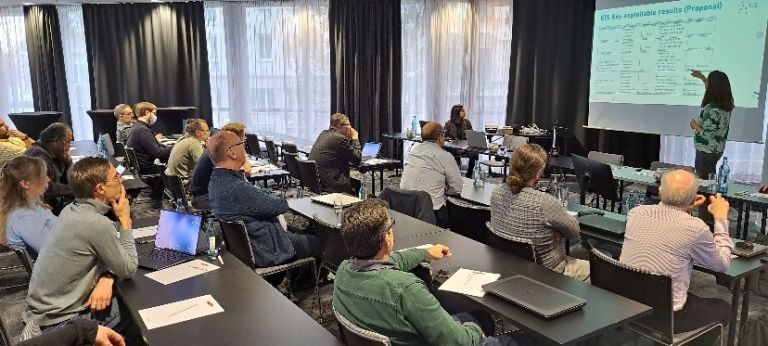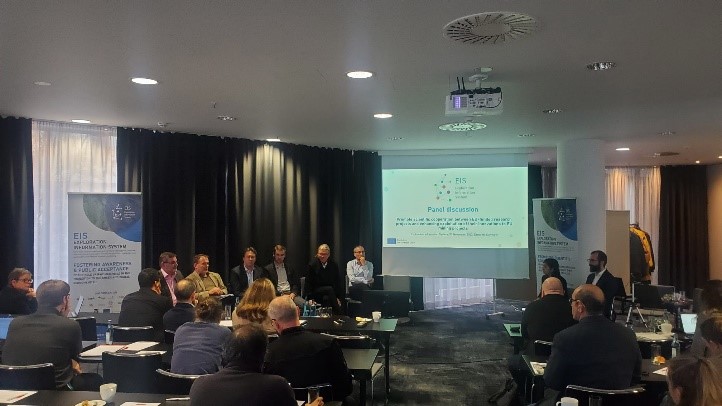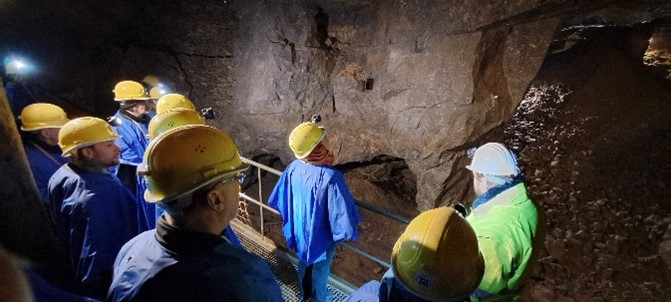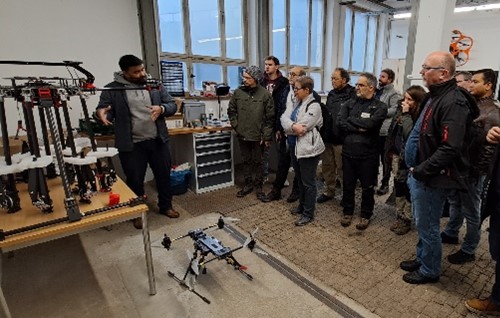CATCHING UP ON OUR PROGRESS! THE EIS PROGRESS MEETING AT DRESDEN.
Dresden, Germany – The EIS project had its official first progress meeting from the 29th of November to the 1st of December 2022 in Dresden / Germany. To ensure the progress of the project’s objectives, this meeting was the perfect opportunity to share with our partners and stakeholders the development and challenges of the project. With 17 partner organisations from over 8 countries and other project representatives, the gathering was a great success.
Organized by our partner Beak Consultants GmbH, the three-day meeting was packed with workshops, clustering events, panel discussions, and even a field trip.

Over the first day, the consortium had the opportunity to exchange on the advances made in the different areas of the project: discussing the progress on data collection, test sites, raising awareness, and the EIS toolkit software. The meeting included brainstorming sessions and workshops that allowed participants to share knowledge on topics such as mineral systems and geology for Critical Raw Materials, how to increase stakeholders’ engagement, as well as the innovative digital exploration toolbox that EIS will develop and its future beyond the funding of EIS. The second day, focused on a more in-depth view of the consortium’s activities since the launch of EIS, as well as, coordinating the upcoming actions and tasks to meet the project’s objectives. It is during this day that partners brought up suggestions for new opportunities to increase the exploration input data, and new testing sites, as well as ideas for the user interface of the EIS QGIS Wizard (the open-source toolkit that EIS will develop).
What is the EIS QGIS Wizard:
The project will put into practice open-source tools for all stages of mineral perspectivity analysis. The package will be published in the form of an EIS QGIS Wizard, which is made available in an open-source geographic information system (GIS) platform, called QGIS. Through the advanced algorithm of the QGIS tool and its user-friendliness, EIS will promote a more responsible standard in the field of mineral exploration. As an example, by increasing the effectiveness of mineral exploration, EIS will drastically decrease the ecological footprint of mining operations.
DISCUSSING THE GREEN AND DIGITAL TRANSITION: ACCEPTING RAW MATERIALS, COOPERATION, AND INNOVATION
On the 30th of November 2022, the EIS project hosted two panel discussions. The discussion focused on the topic of “Fostering awareness and public acceptance of the role of raw materials in the transition to the Green and Digital Economy of EU” and “Promoting scientific cooperation between EU-funded research projects and enhancing exploitation of their innovations to EU mining projects”. The two panels (please refer to the list of panellists below) featured experts from the mining sector, geoscience researchers, data scientists and government representatives. The discussions were moderated by Marie VEYS from LGI Sustainable Innovation and Hafsa MUNIA from the Geological Survey of Finland.

In the first panel, the panellists discussed the current state of raw materials in the transition to the Green and Digital Economy of the EU and its challenges and opportunities. The topic focused specifically on fostering awareness and the engagement of the general public. The panellists highlighted the importance of how to communicate with people about mining operations and shared insights on how there are different levels of “public awareness and acceptance”: there is what the local civil societal thinks about the project and there is, on a national or international level, what NGOs and stakeholders think about the project. The panellists emphasized the difficulty to bring everyone to the discussion table regarding new mining projects. Even when groups, reluctant to the project, are invited to the conversation, they often refuse to participate. The discussion raised the question if a neutral moderator could have a positive impact and bring all sides to the discussion table, and if focusing the discussion on specific concerns could provide a more accessible conversation for the less technical audience.
Throughout the conversation, the panellists shared their experiences and ideas on fostering awareness and engagementideas on fostering awareness and engagement, and provided valuable guidance for future projects on how to include the civil society into this debate.
The diversity of panellists also provided different approaches, practices, and cultural acceptance levels. As an example, the general acceptance of mines is rather high in Saxony, compared to other regions in Germany, as mining is part of its historical heritage and traditional economic activities. However, it is important to highlight that the younger generations raise more concerns on certain mining habits.
These new voices are welcome as they may have a positive impact and bring new ideas and solutions to improve the sustainability of mining in the region.
On the same day, the EIS project held another panel discussion on the topic of “Promoting scientific cooperation between EU-funded research projects and enhancing exploitation of their innovations to EU mining projects”. The wide range of experiences and insights on this topic provided valuable guidance for businesses looking to improve their mining operations safety and efficiency, while at the same time providing a multitude of ideas for scientists and innovative projects to increase their reach.
Overall, the panel discussions were valuable learning opportunities for attendees and provided valuable insights and guidance on the topics of raw materials in the transition to the Green and Digital Economy of the EU and scientific cooperation in the mining industry.
The EIS consortium would like to thank the panellists for their time and expertise, as well as the audience for their presence, and we look forward to hosting more events like this in the future. And a special thanks to our partner Beak Consultants GmbH for organizing the progress meeting and panel discussions.


The meeting was followed by a field trip to Freiberg and Zinnwald. At Freiberg, the consortium had the opportunity to discover the drill core samples from mining projects of Deutsche Lithium and to explore the tools and equipment used by TheiaX and HIF for their hyperspectral mapping. Whereas in Zinnwald, the participants explored the fascinating underground mine with a guide. This excursion was a real treat for all geologists out there and provided great insights on the impact EIS can have on similar projects in the future!
- List of panellists:
- Promoting scientific cooperation between EU-funded research projects and enhancing exploitation of their innovations to EU mining projects: Wolfgang Reimer from Geokompetenz Zentrum GmbH, Richard Gloaguen from Helmholtz-Institut Freiberg für Ressourcentechnologie, Jamie Newall from Golden PET S.R.O., Jiri Zacharias from Univerzita Karlova, Marco Roscher from Saxore Bergbau GmbH, Martin Köhler from Beak Consultants, Vesa Nykänen from Geological Survey of Finland.
- Fostering awareness and public acceptance of the role of raw materials in the transition to the Green and Digital Economy of EU: Antje Wittenberg from Deutsche Rohstoff Agentur, Kerstin Schick from Sächsisches Staatsministerium für Wirtschaft, Arbeit und Verkehr, Daniel Franke-Laske and Tom Jaroka from Sächsisches Landesamt für Umwelt, Landwirtschaft und Geologie, Prof. Bernhard Cramer from Sächsisches Oberbergamt, Diana Ayeh from Helmholtz Centre for Environmental Research GmbH.
